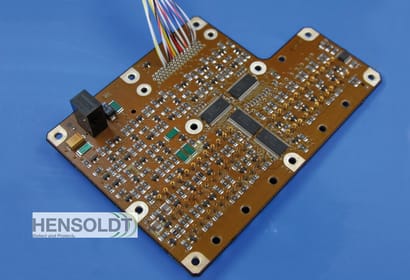Companies developing printers capable of printing 3D electronics for Aerospace and Defense companies (A&D) face many challenges to ensure high performance and reliability to meet industry specifications and standards. In part 1 of this article, I listed some of the challenges in the development of parts for the A&D industry. In part 2, I will discuss how 3D-printed electronics can get innovative PCB ideas off the ground quickly.
3D printing offers endless possibilities for the rapid prototyping of structural electronics, embedded components and sensors, multi-layered wiring and new geometries in A&D industries. The vertical and horizontal PCB will make way for the off-set via or the fully printed coil. Having the ability to print a variety of rigid or flexible substrates, even within the same object, could lead to the discovery of totally new application of products, in all shapes and sizes imaginable.
This technology requires the development of very precise new hardware with three axes and also high performance functional ink formulations offering properties such as conductance, controlled impedance, and resistivity engineered to deliver the right amount adhesion and offering specific mechanical properties. Small deviations from specifications means the PCB needs to undergo new tests. Moreover, it requires advanced software that can convert standard PCB Gerber design files into a 3D-printable file. Software for the design and validation of freeform circuit geometries will also become necessary.
With specialized additive manufacturing technology, A&D developers, engineers, and product designers eventually will be able to 3D-print complete devices, with circuit boards printed within them. The possibilities include flexible circuit boards that bend with interconnections, as well as connections in places currently unimaginable – in a matter of hours. Devices like these might be created to replace damaged wearable devices for military personnel on deployment, for instance. In this way, 3D-printed electronics has the potential to play a primary role in keeping up with the changing needs of A&D customers for device miniaturization and customization.
The first commercially available enterprise 3D PCB printer will be Nano Dimension’s DragonFly 2020 3D Printer. It is a highly accurate and versatile inkjet deposition system for printing multilayer circuit boards. With its innovative and unique hardware, the DragonFly 2020 brings new possibilities to a wide range of R&D, prototyping, and custom manufacturing projects. Nano Dimension is also developing highly conductive silver nano-inks and high performance dielectrics for use with the printers, and has developed novel software enabling Gerber file printing to be seamlessly integrated into the 3D printer.
The DragonFly 2020 3D Printer features a printing size of ca. 20cm x 20cm x 0.3 cm. The 3D printer prints ca. 90 µm (3.5 Mil.) traces of conductive and dielectric ink, based on current performance figures.
3D printed electronics is rapidly developing to be at the forefront of 3D printing technology, and as more and more A&D designers and engineers begin to understand the benefits, it will undoubtedly be utilized to speed development of next-generation electronics – in all shapes and sizes imaginable.
Simon Fried
A co-founder of Nano Dimension, Simon Fried leads Nano Dimension’s USA activities and marketing for this revolutionary additive technology. With experience working in the US, Israel, and throughout Europe, he has held senior and advisory roles in start-ups in the solar power, medical device, and marketing sectors. Previously, Simon worked as a consultant on projects covering sales, marketing, and strategy across the automotive, financial, retail, FMCG, pharmaceutical, and telecom industries. He also worked at Oxford University researching investor and consumer risk and decision making.
